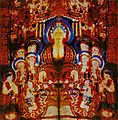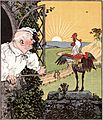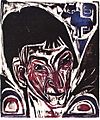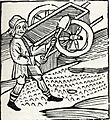Woodcut facts for kids
A woodcut is a special way of printing pictures. Imagine a block of wood. An artist carves an image into this block. The parts of the wood that will print are left raised, while the parts that won't print (the "white" areas of the picture) are cut away. Tools like knives or chisels are used for this. So, the raised parts of the wood are what will show up as black or colored lines in the final print.
The wood block is usually cut along the natural direction of the wood grain. In Europe, people often used beechwood. In Japan, a special kind of cherry wood was popular.
Once the carving is done, ink is rolled over the surface of the wood block. A tool called a brayer (which is an ink-covered roller) is used for this. The ink sticks to the raised parts of the wood but doesn't go into the cut-away areas. Then, paper is pressed onto the inked block, and the image is transferred! Sometimes, woodcuts are called by a more formal name: xylography.
Contents
What is a Woodcut Print?
A woodcut print is one of the oldest and simplest ways to make many copies of an image. It's a type of printmaking where the image is carved into a block of wood. The parts that are cut away will not print, and the parts left raised will transfer the ink to the paper. This creates a bold, graphic look.
How are Woodcuts Made?
Making a woodcut involves several steps:
- Designing the Image: First, the artist draws or sketches the image they want to print onto the wood block.
- Carving the Wood: Using special tools like knives, gouges, and chisels, the artist carefully carves away the areas of the wood that they don't want to print. These are the parts that will be white or blank in the final picture. The parts that are left raised will hold the ink.
- Inking the Block: Once the carving is finished, ink is rolled onto the raised surface of the wood block.
- Printing the Image: A piece of paper is placed on top of the inked block. Pressure is then applied, either by hand (rubbing the back of the paper) or with a printing press. This transfers the ink from the wood block onto the paper, creating the print.
- Drying the Print: The finished print is carefully removed and allowed to dry.
History of Woodcuts: When Did They Start?
Woodcuts have a very long history! They were first used in China around the 9th century. The earliest known woodcut print is a Buddhist scroll from the year 868 AD. In China, woodcuts were used to print texts, images, and even paper money.
Woodcuts became popular in Europe in the 14th century. They were often used to print religious images and playing cards. By the 15th century, artists like Albrecht Dürer made woodcuts into a high art form, creating detailed and powerful images.
In Japan, woodcuts became very famous during the Edo period (1603-1868) with the rise of ukiyo-e prints. These prints often showed scenes from everyday life, actors, beautiful women, and landscapes.
Famous Woodcut Artists
Many artists throughout history have used woodcuts to create amazing art.
- Albrecht Dürer (1471-1528): A German artist known for his detailed and dramatic woodcuts, like "The Four Horsemen of the Apocalypse."
- Hokusai (1760-1849): A Japanese ukiyo-e artist famous for "The Great Wave off Kanagawa," which was made using woodblock printing.
- Hiroshige (1797-1858): Another Japanese ukiyo-e master, known for his beautiful landscape prints, especially his series "The Fifty-three Stations of the Tōkaidō."
- Ernst Ludwig Kirchner (1880-1938): A German Expressionist artist who used woodcuts to create bold and emotional images.
Gallery of Asian Woodcuts
-
Jiaozi (currency), 10th century, Sichuan, China.
-
Dragon, Japanese ukiyo-e woodcut, c. 1750-1900.
-
Modern woodcut Carp Painting, Dong Ho Painting, Vietnam.
Images for kids
-
The Four Horsemen c. 1496–98 by Albrecht Dürer, showing the Four Horsemen of the Apocalypse
-
Block Cutter at Work woodcut by Jost Amman, 1568
-
Bijin (beautiful woman) ukiyo-e by Keisai Eisen, before 1848
-
Children's book illustration by Randolph Caldecott; engraving and printing by Edmund Evans, 1887
-
Ernst Ludwig Kirchner, Portrait of Otto Müller (1915)
-
The Prophet, woodcut by Emil Nolde, 1912
-
The Crab that played with the sea, Woodcut by Rudyard Kipling illustrating one of his Just So Stories (1902).
-
Odawara-juku in the 1830s by Hiroshige, from his series The Fifty-three Stations of the Tōkaidō
-
Chiaroscuro woodcut showing Playing cupids by an unknown 16th-century Italian artist
-
Actor Ichikawa Ebizō IV as Takemura Sadanoshin, Japanese woodcut by Sharaku, 1794.
See also
 In Spanish: Xilografía para niños
In Spanish: Xilografía para niños



















